
Benvenuti a Lampedusa – welcome to Lampedusa. Credit: Maldusa
Introduction
In the second half of 2023, Alarm Phone was alerted to 653 boats in distress in the central Mediterranean Sea. Over the whole year, we were alerted to 1,203 boats in this region – an unprecedented number of cases, nearly doubling the number of the previous (record) year of 2022, when we assisted 673 boats.
The increase in cases is also a reflection of the overall increase in migratory dynamics in the central Mediterranean Sea, with more than 157,600 people succeeding in subverting Europe’s violent borders and reaching Italy by boat. In the four summer months alone, more than 83,000 people crossed the sea – figures that we have not seen in this region since around the mid-2010s. When we look back to the year of 2023, we can thus speak of a long summer of migration in the central Mediterranean.
In this analysis, we focus on the central Mediterranean route via Tunisia, which has seen a sharp increase in migratory dynamics in 2023. Especially from Sfax, hundreds of boats left and reached Lampedusa. In reaction to the many crossings, border violence along the Tunisian route increased as well. We also provide a comprehensive chronology of the last six months of 2023, offering in great detail an account of developments as they unfolded. As nobody else is doing so, we need to create our own archive of migrant struggles, acts of solidarity, and forms of border violence at sea.
Also in 2024, we promise to continue in our struggle alongside people on the move. In our daily practice, we struggle against borders, for ferries, not Frontex, and the freedom of movement for all.
The Tunisian Route
Lampedusa in September 2023
In the week of the 11th to the 17th of September 2023, more than 11,000 people made it bravely to Lampedusa. Most of the boats departed from the region of Sfax, in Tunisia. Not all who tried succeeded. Some were intercepted by the Libyan and Tunisian authorities and pushed back to the places they were trying to escape from. Some died, either during rescue or shortly after disembarkation. A six-month-old baby was amongst the latter. With a capacity of 350 places only, the Lampedusa Hotspot could not host what would average at around 7,000 people simultaneously on the island.
As the hotspot doors opened, the center was physically unable to accommodate so many people, and for a few days, the streets of Lampedusa were the scene of unusual encounters, between people on the move and the island’s locals, usually kept apart by the hotpot’s fences. An impressive solidarity by the local population developed, helping the survivors who had just disembarked, providing them with hot meals, blankets and medical care. As described by the grassroot network Maldusa, based in Lampedusa:
„…Over the past two days, however, without police teams in manhunt mode, Lampedusa streets, public spaces, benches and bars have been filled with encounters, conversations, pizzas and coffees offered by local inhabitants. Without hotspots and segregation mechanisms, Lampedusa becomes a space for enriching encounters and spontaneous acts of solidarity between locals and newly arrived people. Trays of fish ravioli, arancini, pasta, rice and couscous enter the small room next to the church, where volunteers try to guarantee as many meals as possible to people who, taken to the hotspot after disembarkation, had been unable to access food and water for three days. These scenes were unthinkable only a few days before…”

Public event organised by Maldusa in Lampedusa, October 2023. Credit: Alarm Phone
Increased border control along the Tunisian route
These scenes of what has been dubbed the ‘little summer of migration’, in reference to arrivals in Europe during the ‘long summer of migration’ in 2015, were short-lived, however. A few days later, the doors of the hotspots closed again, the police presence once more took over the island, and the Italian and European authorities rushed to take new measures to try and curb the arrivals by the sea.
On the 17th of September, the European Commission President Ursula von der Leyen, and Giorgia Meloni met in Lampedusa, after the Italian authorities complained that the country was placed under “unsustainable pressure”. While von der Leyen acknowledged that the issue was “a European challenge and needs a European answer”, she presented a 10-Point Plan for Lampedusa.
This plan uses exactly the same old recipes, as ineffective as they are violent, that the European Union has been applying for decades to its external borders: more controls (notably via the reinforcement of the Frontex agency), more deportations and repression. The plan also calls for accelerated implementation of the EU-Tunisia memorandum of understanding signed on 16 July 2023, for which €150 million was pledged towards the “fight against illegal migration”.
In September 2023, Tunisia received a first transfer under the agreement of €67 million
“to finance a coast guard vessel, spare parts and marine fuel for other vessels as well as vehicles for the Tunisian coast guard and navy, and training to operate the equipment.”

Lampedusa. Credit: Maldusa
The implementation of a push-back regime by proxy in Tunisia
As emphasized in an article published by the Civil MRCC, it is now clear that the European Union and its member states are attempting to replicate in Tunisia the regime of refoulement by proxy set up in Libya just a few years earlier. This strategy is based on four different pillars: strengthening the capacities of the Tunisian coastguard (with equipment and training), setting up a coastal surveillance system, creating a ‘functional’ Maritime Rescue Coordination Centre (MRCC) and declaring a Tunisian Search and rescue region (SRR).
During the second semester 2023, several steps were taken in this direction. In a letter to the European Council, leaked by Statewatch in October 2023, the European Commission president Ursula von der Leyen highlighted the provision of vessels and support to the Tunisian coast guards:
“Under the Memorandum of Understanding with Tunisia, we have delivered spare parts for Tunisian coast guards that are keeping 6 boats operation and others will be repaired by the end of the year.”
In addition to supplying equipment, the European countries are also organizing training courses to enhance the skills of the Tunisian coastguard. In a document presenting the “EU Support to Border Management Institutions in Libya and Tunisia” for the year 2021, the European Commission announced the creation of a “coast guard training academy.” In Tunisia, the project consists of implementing a training plan, rehabilitating the physical training environment of the Garde Nationale Maritime, and enhancing the cooperation between Tunisian authorities and all stakeholders, including EU agencies and neighboring countries. Implemented by the German Federal Police and the International Centre for Migration Policy Development (ICMPD), the project started in January 2023 and is supposed to run until June 2026, to the sum of 13,5 million EUR.
On 17 November 2023, the ICMPD also announced on its Linkedin account the inauguration of the Nefta inter-agency border management training center, as a benefit to the three agencies responsible for border management in Tunisia (Directorate General Directorate of Borders and Foreigners of the Ministry of the Interior, the General Directorate of Border Guard of the National Guard and the General Directorate of Customs).
With the support of the EU and its Member States, the creation of a “functioning Tunisian MRCC” is also taking shape. On the website of Civipol, the French Ministry of the Interior’s service and consultancy company, a new project entitled “Support for Search and Rescue Operations at Sea in Tunisia” is mentioned in a job advertisement. It states that this project, funded by the European Union, implemented together with the GIZ and starting in September 2023, aims to “support the Tunisian authorities in strengthening their operational capacities (fleet and other)” and “provide support to the Tunisian authorities in strengthening the Marine Nationale and the MRCC via functional equipment and staff training.” In October 2023, the German development agency GIZ also published a job offer for a project manager in Tunisia, to implement the EU-funded project “Support to border management institution (MRCC)” in Tunisia.
In September 2023, several media outlets also reported that the EU was actively working to set up a SAR zone in Tunisian waters as part of the implementation of the memorandum of understanding signed with Tunisia. The establishment of a functional MRCC and the creation of an official Tunisian SRR represent a major challenge for the EU, with the aim to allow Tunisia to engage actively in coordination of interceptions and to enable the European states to escape from their SAR responsibilities.

General Strike in Zarzis on the 18.10.2022. Credit: Felice Rosa
Continuous human rights violations and violences against people on the move
These plans are being pursued despite the fact that Tunisia can in no way be considered a safe country, neither for Tunisians nor for migrants trying to flee the country, and despite the numerous rights violations committed by the Tunisian Coast Guard against people on the move that have been reported by civil society actors. In August 2023, Alarm Phone published the testimony of a survivor of one of those numerous attacks.
As highlighted by the report Routes of Torture: Mapping violations suffered by people on the move in Tunisia, published in December 2023 by OMCT (World Organisation Against Torture) the deportations of people on the move to border areas continued. The report documents the scale and nature of human rights violations committed in Tunisia between July and October 2023 against migrants, refugees, and asylum seekers, including
“forced evictions from their homes, physical and psychological violence by both citizens and security agents, denial of access to healthcare, arbitrary arrests, and detentions, arbitrary and forced displacement within Tunisia”.
Alarm Phone has observed that the deportation of people intercepted at sea by the Tunisian coast guards has become a systematic practice in recent months. Those practices were also reported by different media outlets. They also affect survivors of shipwrecks, as well as people of nationalities likely to receive international protection in Tunisia via the UNHCR.
After peaking again in September 2023 (following the July peak), deportations continue on a daily basis. At the Libyan border, an agreement seems to have been reached between Tunisian authorities and Libyan militias, whereby some migrants report being handed over to the Libyans in exchange for oil and other goods from Libya. The migrants then report being taken to the Al-Assah center, a military base around thirty kilometers from Zuwara, before being handed over to various militias. For their part, the Libyan Border Guard announced the activation of electronic surveillance observatories on the border with Tunisia in the Al-Assah sector.
At the Algerian border, people being turned back are caught in the crossfire between Tunisian and Algerian authorities. As reported by the Alarm Phone Sahara network, a series of people have been turned back from Tunisia to Algeria, and then from Algeria to Niger. After being expelled to Algeria, other people try to cross the Moroccan border, but here, too, they encounter numerous obstacles and violence from the Moroccan authorities. As a result, many people on the move fall victim to this game of ping-pong between the authorities, who turn them back from one country to another.
In the face of these deportations, UN agencies have remained silent. While people on the move take refuge in front of UNHCR or IOM headquarters, hoping to be protected from violence by the Tunisian authorities, raids have also been reported in front of these institutions.
Most of those who are still in Tunisia are in an extremely precarious situation. Many migrants are homeless, have been evicted from their homes and have lost their jobs. In front of the IOM office in Tunis, hundreds of people continue to gather, forced to demand their “voluntary” return to their country of origin. In 2023, 2,557 migrants benefited from the IOM “voluntary” return programme from Tunisia to their country of origin, representing a 45% increase on 2022, when 1,614 migrants had received assistance with voluntary return and reintegration. These returns, which are clearly not “voluntary” as soon as we consider the broader context, are financed by the European Union, and show that the situation is becoming increasingly unbearable for migrants in Tunisia.

Metal boat via Tunisia. Credit: Maldusa
The struggle to overcome the EU border regime goes on!
The drop in the number of boats using the Tunisian route in October should not obscure the autonomy of migration and the ability of people on the move to invent new strategies to overcome borders. As we have seen for a long time, reinforcing borders does not stop the movement of people, but only diverts the routes and often makes them more dangerous.
Alarm Phone has been able to observe that in October, for instance, departures from Libya, especially around Zuwara, increased: several boats carrying around 50 people arrived in Lampedusa, with an average travel time of 24 hours only. Also remarkable were the 9 big fishing vessels with several hundreds of people on board which landed in Lampedusa in October and November 2023.
Despite all the obstacles, people on the move continue years after years to overcome the unjust and violent EU border regime. We, as Alarm Phone, make the promise to continue to support them and fight for an open Mediterranean Sea.

Image showing protest and commemoration in Zarzis. Credit: Alarm Phone
Alarm Phone Chronology July-December 2023
JULY
In July, Alarm Phone was alerted to 141 boats in distress, among them 36 departing from Libya, 104 from Tunisia, and one from Lebanon. NGO vessels rescued a total of 23 boats that month -not all of them had alerted Alarm Phone. One boat was rescued by a merchant vessel and brought to Italy. In several cases, the Italian Coastguard rescued boats when they had almost reached Lampedusa, and they also coordinated some rescue operations of boats heading towards Sicily or Calabria. We know of 14 interceptions by the so-called Libyan Coastguard and one by the Eastern Libyan militia vessel Tareq Bin Zayed. We learned of five shipwrecks in July.
On 1 July, the Humanity 1 reported that the night before, they had rescued a total of 163 people in distress at sea in four rescues in international waters.
On 3 July, the merchant vessel CALAJUNCO M rescued 70 people in the Maltese Search and Rescue (SAR) zone and disembarked them in the port of Trapani.
On 4 July, after house raids in Sfax, 48 people were arrested and 20 of them expelled to Libya by the Tunisian military. They were urgently asking for help from the border region, as they were threatened by gunmen. Money and food were taken away and their mobile phones destroyed.
On 5 July, over 300 people were deported to the Libyan border and abandoned in the middle of the desert.
On 6 July, the Open Arms rescued a boat in distress with 100 people on board, who had called Alarm Phone during the night.
On the same day, more than 1,220 people arrived in Lampedusa in thirty landings.
On 7 July, Alarm Phone was contacted by several groups of people who had been deported from Tunisia to the Tunisian-Libyan border region. They were lost in the desert and fearing for their lives. Some reported gun shots and that a woman gave birth. Others were deported to the Algerian border.
On the same day, the so-called Libyan Coastguard fired multiple shots when the Ocean Viking was conducting a rescue operation, following a mayday relay. The shots came from a vessel that the EU had donated to the Libyans in a ceremony on 22 June.
On 8 July, Seabird witnessed the interception of about 250 people, who had alerted Alarm Phone on the day before, by the Tariq Ben Zayed militia vessel. They were handed over to the so-called Libyan Coastguard and detained in Benghazi.
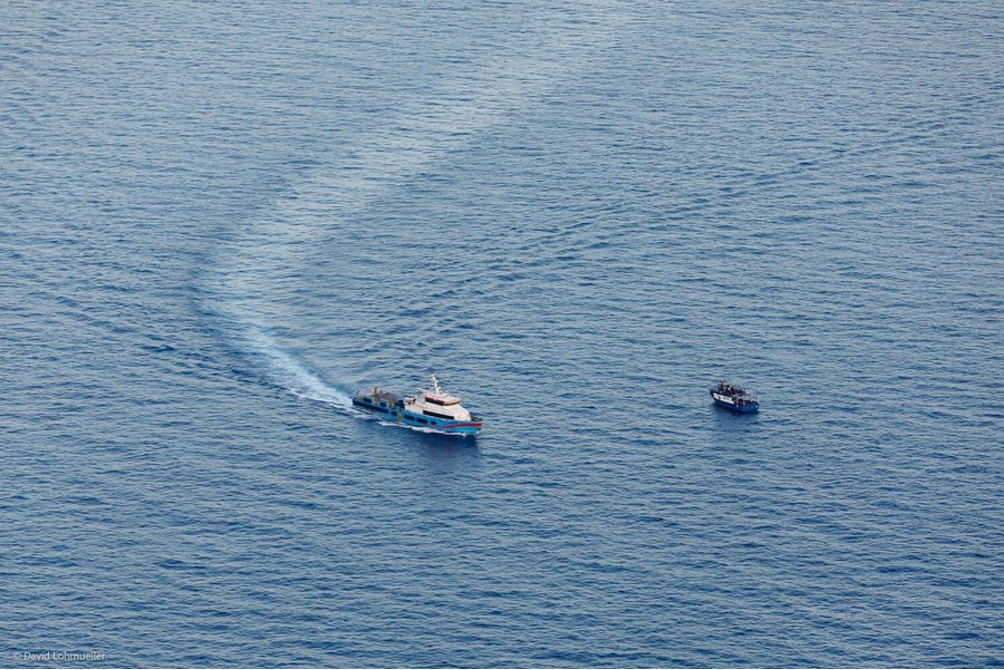
Tariq Ben Zayed militia vessel intercepts boat. Credit: David Lohmüller
On the same day, a Maltese diplomatic delegation met for the first time with Khalifa Haftar in Benghazi for talks on “migrant smuggling”.
On 10 July, 571 people arrived in Lampedusa on board of barges and iron boats. 1,800 were in the hotspot.
On the same day, Refugees in Libya reported that in Tripoli, in front of the UNHCR office, hundreds of women and children who fled from Sudan started a sit-in protest to demand protection.
On 11 July, Dbeih, head of the western Libya interim government, and Borg, Malta’s foreign minister, met to discuss cooperation to combat „illegal“ migration.
On the same day, comrades of Refugees in Libya who had been detained for 18 months in Ainzara detention centre after their three months long protests at the UNHCR office, were finally released.
On 12 July, a small boat departing from Tunisia capsized a few miles from the coast of Lampedusa. The 15 survivors were rescued by a Tunisian fishing boat and then transferred to an Italian patrol boat that disembarked them in Lampedusa. Among the 46 victims are seven children.
On 13 July, Alarm Phone was once again in contact with the approximately 150 people stuck in the desert at the Tunisian/Libyan border. Some had been there for six days in the sweltering heat, without water and food.
On 14 July, Alarm Phone was alerted to eleven boats between Tunisia and Italy, trying to reach Lampedusa.. The sailing ship Nadir rescued more than 100 people in distress on the instructions of the Italian Coast Guard. Many of these people were victims of the racist violence in Tunisia.
On the same day, dozens of human rights defenders and activists demonstrated in Tunis in solidarity with the people on the move stranded at the borders between Tunisia and Libya.
On 16 July, the European Union and Tunisia signed a memorandum of understanding for a “strategic and comprehensive partnership”, aimed at combatting irregular migration and boosting economic ties between the EU and Tunisia, negotiated also by the Italian far-right. At the same time, the Tunisian authorities deported people on the move to no man’s land near the borders. Alarm Phone continued to be in contact with those forced to the border regions and sought to amplify their voices.
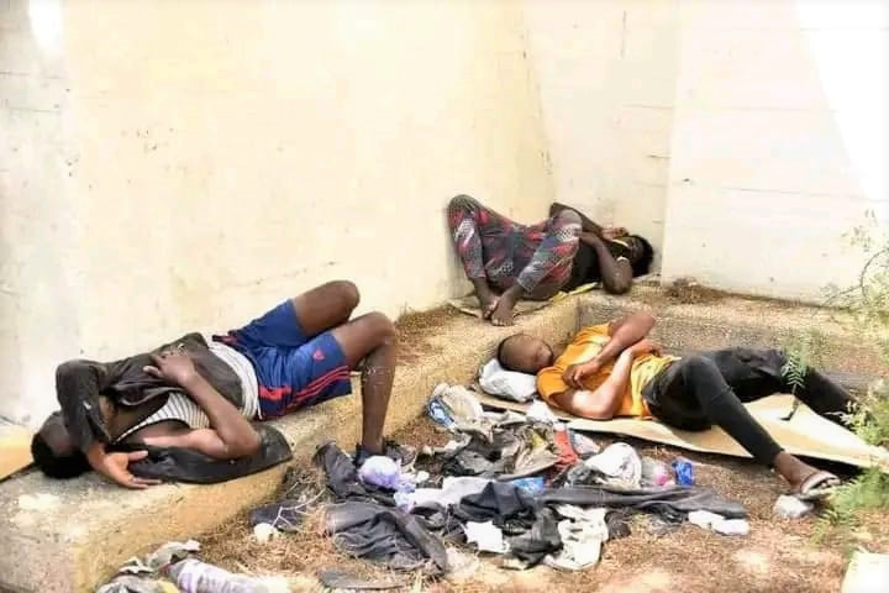
People arrested in Zarzis and deported to the desert. Photo sent by people deported.
Between 15 and 17 July, the Geo Barents conducted twelve rescues within the Maltese SAR, coordinated by the Italian Rescue Centre. Eleven of the boats had left Tunisia. A total of 462 survivors were taken on board, before Italian authorities instructed the disembarkation of 116 people in Lampedusa. For the remaining 346 people, Livorno was assigned as port of safety.
On 18 July, UN experts published their concerns about “discriminatory treatment of sub-Saharan migrants and urged authorities to take urgent measures to stop collective expulsions and protect the human rights of migrants”. Also in the EU Parliament, there were protests and questions whether the deal with Tunisia was even legal.
On 19 July, the Nadir found eight boats in distress within 14 hours with a total of 341 people on board. In cooperation with the Italian Coastguard, the crew assisted several hundred people.
On the same day, the rescue ship Mare*Go assisted nine boats in distress (about 400 people) on the way to Lampedusa.
In the days before, more than 2,000 people had arrived in Lampedusa, fleeing mostly from Sfax, Tunisia.
On 20 July, a boat in distress in the Maltese SAR zone was illegally pushed back by the so-called Libyan Coastguard.
On the same day, a Portuguese ship, engaged in the FRONTEX operation THEMIS, rescued a boat 12 nautical miles of the island of Pantelleria.
On 21 July, Italian police arrested two young men who were among those rescued after their boat capsized off Lampedusa on July 12. They stand accused of aiding and abetting clandestine migration.
On 22 July, Italy invited other Mediterranean countries to Rome for an international conference aimed at extending the EU deal with Tunisia to curb the arrival of people on the move in Europe. Refugees in Libya organised their own counter summit.
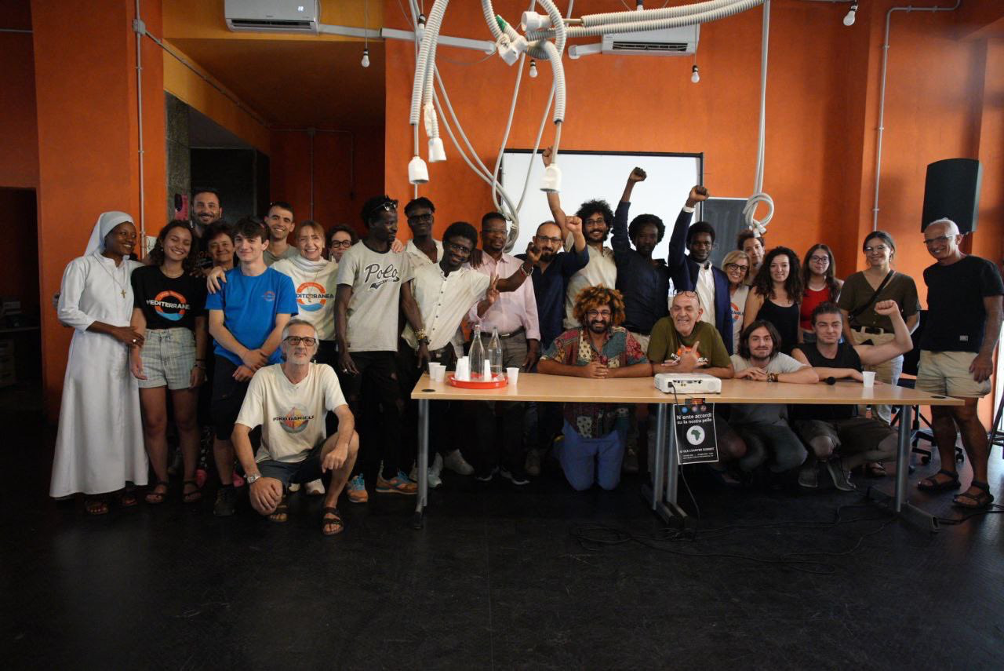
Picture taken by Refugees in Libya at the counter summit.
On July 24, over 2,000 people were transferred from Lampedusa to Sicilian ports. In the week following the signing of the EU-Tunisia memorandum, 7,359 people on the move landed in Italy from Tunisia – the highest number of landings ever.
On 25 July, a shipwreck happened between Sfax and Lampedusa. Alarm Phone could never reach the 42 people who were said to have been on board. Later we heard that six people died in this incident. Survivors reported that the crew of a Tunisian fishing vessel tried to steal their engine, causing them to fall into the sea.
On 26 July, Haftar’s Libyan militia vessel Tareq Ben Zayed intercepted 300 people in distress in Maltese SAR zone after a Frontex airplane had been on site.
On the same day, Alarm Phone was alerted to a boat in distress between Corfu and Italy. The next day we learned that the 129 people who were on board were rescued to Leuca/Italy.
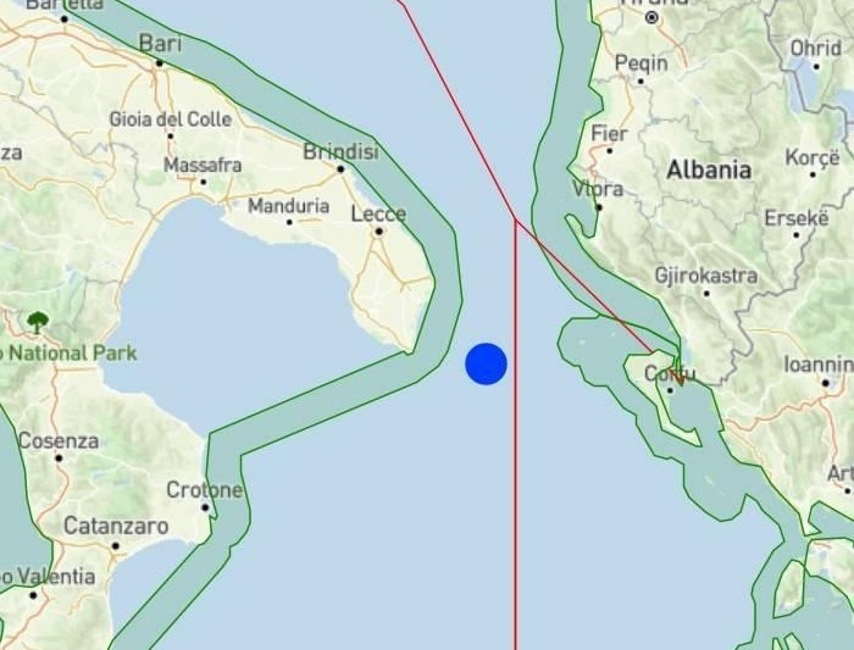
Map showing the position of the boat. Photo: Alarm Phone
On 30 July, security forces conducted a raid in a warehouse south of Tobruk and arrested 385 people on the move of mainly Pakistani nationality.
AUGUST
In August, Alarm Phone was alerted to 153 boats in distress, among them 70 departing from Libya, 81 from Tunisia, one from Lebanon. and one from Turkey. NGO vessels rescued 19 boats that month, not all of whom had alerted Alarm Phone. Two boats were rescued by merchant vessels and brought to Malta. In several cases, the Italian Coastguard rescued boats when they had almost reached Lampedusa. Italian authorities also coordinated some rescues of boats heading towards Sicily or Calabria. We know of 17 interceptions by the so-called Libyan Coastguard and four by the Eastern Libyan militia vessel Tareq Bin Zayed. We learned about 13 shipwrecks.
On 1 August, a boat in distress with 170 people on board was intercepted by the Libyan militia vessel Tariq Bin Zayed in international waters and pushed back to Libya, although three merchant vessels were sailing nearby and could have intervened faster.
On 2 August, Alarm Phone reported a distress case. Seabird reached the position and saw the boat, which had caught fire. Later, the militia boat Tareq Bin Zayed was documented as heading to Libya with the people on board. While the Open Arms rescued 24 people in the same area, the so-called Libyan Coastguard intercepted two boats and threatened Open Arms, telling them leave the area.
On 3 August, the Coastguard of Lampedusa ran out of fuel and called NGO vessels to help as dozens of boats were moving toward the island and needed support. 1377 People in 38 boats arrived in Lampedusa on that day.
On 4 August, the sailing ships Nadir and Astral carried out several complicated rescue operations and the Nadir took 150 people on board, as Italian authorities had no ships available.
On the same day, the Tunisian coastguard interventions led to the overturning of a boat and caused the death of a 17year-old, according to the testimony of the survivors.
On 5 August, two shipwrecks happened between Tunisia and Lampedusa. More than 30 people went missing. 57 people were rescued by the Italian Coastguard and two corpses were recovered.
On 6 August, a group of 27 people on the move who had called Alarm Phone was rescued by two merchant vessels and brought to Malta. Another boat was rescued to Catania. We did not get information concerning five other boats in distress.
On 7 August, we learned about more shipwrecks that had occurred in terrible weather conditions over the days before. In total, more than 90 people drowned. 41 people died in a single shipwreck off Lampedusa.
On the same day, it was revealed that Egypt has received 23 million Euro via a EU fund to prevent migration to Europe. The money would be spent on two new patrol boats.
On 8 August, we learned that 24 people who had alerted Alarm Phone when in the Maltese SAR zone were rescued by the merchant vessel PGE TORNADO, but Malta, Italy and Greece refused to assign a port and the merchant vessel was told to return the people to Libya. The returned people were imprisoned in Misrata.
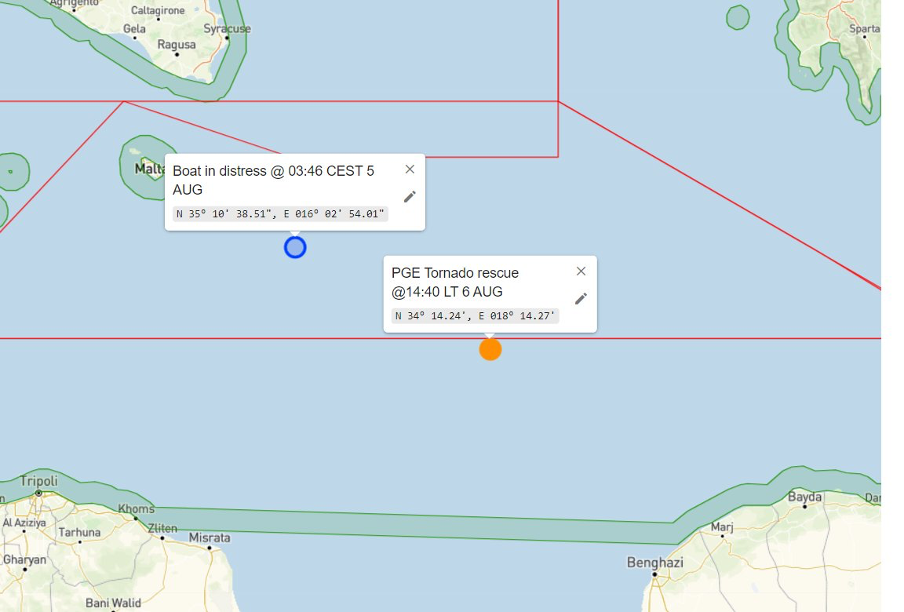
Map showing the positions of the boat and of the merchant vessel. Photo: Alarm Phone
On 9 August, Pope Francis appealed to world leaders to come to the emergency assistance of migrants trapped in the deserts of North Africa.
On 10 August, the Libyan ministry of the Interior announced that 174 people who had been stuck between the Tunisian and Libyan borders were transferred to Al-Assah, from where they would be repatriated. Others were brought to a centre of IOM in Tataouine, Tunisia.
On 11 August, more than 2,000 people arrived in Lampedusa within 24 hours. The NGO vessels Astral, Humanity1 and Ocean Viking performed several rescues. The captain of Astral received instructions from the Italian Coastguard to ask Tunisia for disembarkation, despite Tunisia not being a place of safety. The Ocean Viking rescued a total of 623 people in 15 operations.
On 12 August, a shipwreck happened off Gabès, Tunisia. Only 13 of the 20 people on board were rescued. On the following day, more shipwrecks off Tunisia were reported.
On 13 August, the self-organisation Boza Fii launched a demonstration against FRONTEX in Dakar, Senegal.
On 15 August, arrivals in Italy exceeded 100,000 landings since the beginning of the year, an increase of 101% to the same period of 2022.
On 16 August, the Tunisian Coastguard announced that, during the prior night, they had foiled 18 sea crossings and intercepted 630 people.
On the same day, Seabird documented how the merchant vessel MARIDIVE “rescued” about 30 people, forcing them onto their boat to hand them over to the so-called Libyan Coastguard. The people had called Alarm Phone when in distress. Frontex had also spotted the boat and probably informed the Libyans.
On 17 August, the Geo Barents rescued 55 people who had alerted Alarm Phone. During the rescue operation, a boat of the so-called Libyan Coastguard approached the Geo Barents, trying to intimidate them and to force them out of the area.
On 18 August, a group which had left from Lebanon alerted Alarm Phone from the Maltese SAR zone to report that they were threatened by gunfire from an unknown small vessel carrying the Libyan flag. Chased by this boat, the people tried to reach Greek waters. Alarm Phone lost contact, Greek and Maltese authorities did not provide any answers. Relatives told us that the peoplewere abducted to Libya.
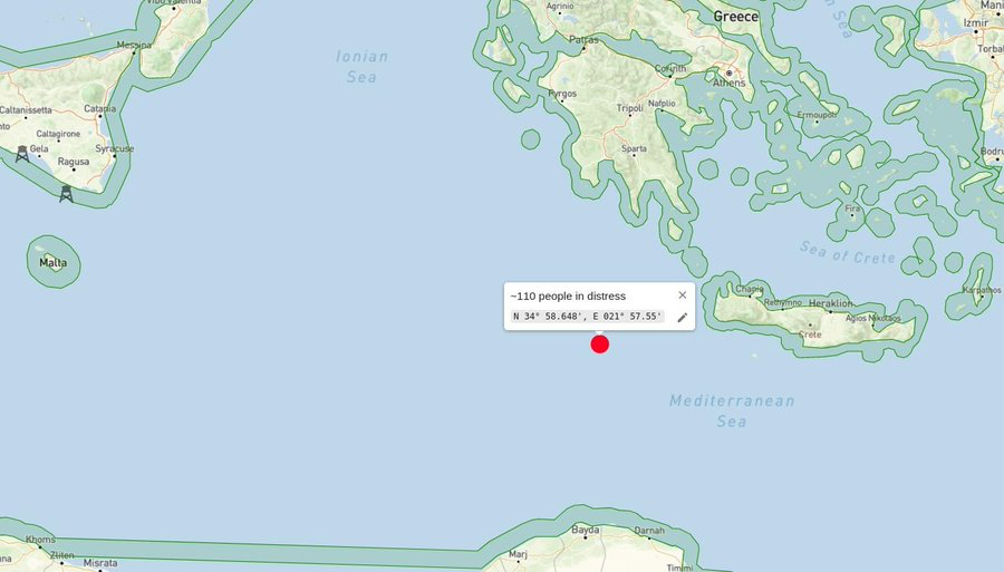
Map showing the position of the boat, added by Alarm Phone.
On 21 August, Alarm Phone was alerted to about 500 people who were pushed back and forth at the Tunisian-Algerian border. Among them were children.
On the same day, Libyan authorities deported 95 people from a detention centre in Benghazi to Egypt, Ghana and Pakistan and 492 people from Tripoli to Egypt and Nigeria.
On 23 August, refugees from Sudan, among them many women and children, demanded evacuations to safe countries at the UNCHR office in Libya, but were ignored and a few hours later attacked by militias.
On 24 August, the Geo Barents rescued two boats that had alerted Alarm Phone in the Libyan SAR zone. Later, they spotted the so-called Libyan Coastguard forcefully taking people back to Libya.
On 25 August, according to the news agency ANSA, 1,826 people arrived in Lampedusa in 64 boat landings – a record for the island in terms of the number of rescues and people arriving in a single day.
On 26 August, another boat was forced back to Libya, probably by the Tareq Bin Zeyad militia vessel, although a merchant vessel had been willing to rescue them to safety.
On 27 August, we learned that about 40 people had stranded on Lampione island the evening before. They were rescued two days later.
On 28 August, Alarm Phone alerted authorities about 39 people who had escaped Libya several days before and were drifting as they ran out of fuel. Eventually, they were rescued by the merchant vessel NIKKEI SIRIUS and brought to Malta.
On 31 August, the Italian government announced that they were intensifying its efforts to tackle the arrival of large numbers of people by sea. Measures include stepped-up missions to countries of origin and transit, providing patrol boats to Tunisia, and a security package.
SEPTEMBER
In September, Alarm Phone was alerted to 127 boats in distress, among them 58 departing from Libya, 69 from Tunisia. NGO vessels rescued 19 boats, not all of which had alerted Alarm Phone. In several cases, the Italian Coastguard rescued boats once they had almost reached Lampedusa. Italian authorities also coordinated some rescue operations of boats heading towards Sicily or Calabria. We know of 24 interceptions by the so-called Libyan Coastguard. We learned about 4 shipwrecks.
On 2 September, a boat which had left from Benghazi area, shipwrecked off the coast of eastern Libya. Some people were rescued, others went missing and two bodies were recovered.
On 4 September, Italian prime minister Meloni and her Greek counterpart Mitsotakis decided to form an alliance of Mediterranean EU member states to work on migration policies, including the intensification ofcooperation with African countries of origin and transit.
On 5 September, the Louise Michel rescued two boats, carrying 24 and 44 people. One of them had alerted Alarm Phone.
On 6 September, we learned that 16 people who had called Alarm Phone in distress about 270km from Malta, were illegally forced back to Benghazi in Libya.
On 11 September, a shipwreck occurred on the Tunisian route. The Nadir informed authorities but the 40 missing people were not found.
On the same day, Mediterranea Saving Humans was threatened by Italian authorities, told to remove all rescue equipment on the Mare Ionio. Otherwise they would be arrested.
On 11 and 12 September, the storm Daniel unleashed deadly flooding in eastern Libya. Thousands died and thousands more went missing in and around Derna. The number of victims far exceeded 10,000 people, among them many people on the move.
On 13 September, the media reported that the hotspot in Lampedusa was accommodating more than 6,000 people and collapsed, after 5,112 people had arrived the day before in 110 boat landings.
People on the move were protesting and demanding to leave the pier, where they had to wait for hours. Lampedusa’s streets, public spaces, benches and bars, became sites of encounters and conversations. Many local inhabitants offered food and drinks.
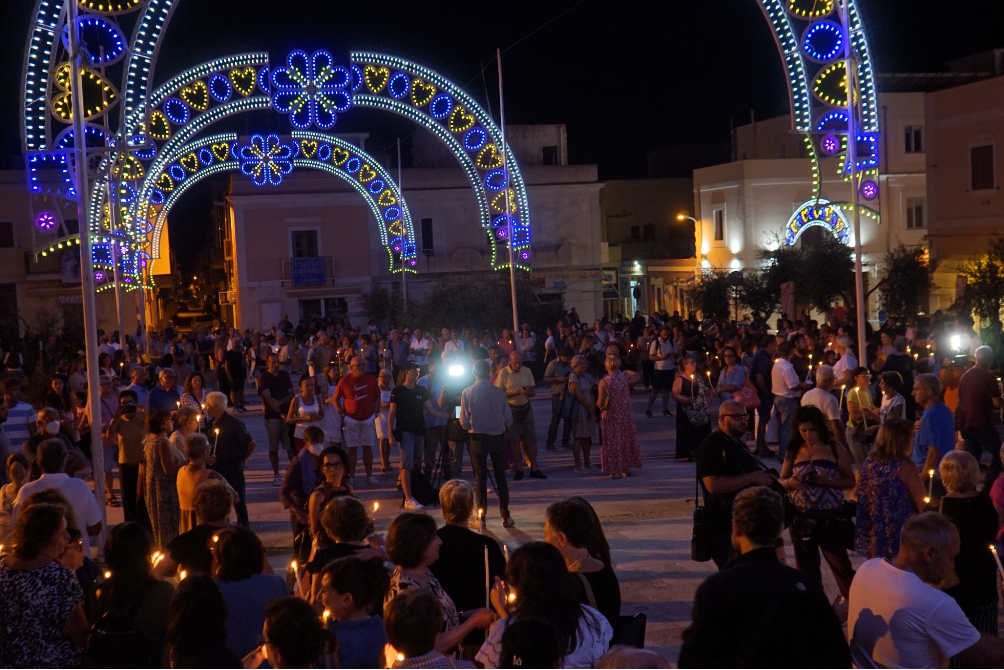
Situation in the streets of Lampedusa on 13 September. Credit: Maldusa
On 14 September, the Tunisian government decided to bar a delegation of members of the EU Parliament who wanted to meet organisations of the civil society, trade unions, and members of the opposition and who had criticized the EU-Tunisia migration deal concluded in May.
On 15 September, Tunisian police, supported by planes and anti-terrorism units, arrested hundreds of people on the move and seized boats in the coastal region of Sfax. The operation, which the government said was ordered by President Kais Saied, came as the Italian island of Lampedusa struggled with a record number of landings.
On 17 September, EU president von der Leyen visited Lampedusa together with Meloni and promised support to Italy to deal with the high number of arrivals.
On 18 September, a large number of NGOs and associations published a common statement: “Arrivals in Lampedusa: Solidarity and resistance in the face of Europe’s reception crisis!”
On 19 September, the Aurora prevented a pullback by the so-called Libyan Coastguard with Pilotes Volontaire’s help. 40 people were taken on board, but survivors stated that four people had drowned. The Libyan patrol vessel, which was close to the boat and had some people on board, tried to intimidate the crew of the Aurora.
On 20 September, Alarm Phone was alerted by about 25 people adrift off Benghazi. A relative of someone on board told that the people in distress were being shot at from a boat carrying a Libyan flag. At one point, we could not reach the people in distress any longer and authorities kept silent on the fate of this group.
On the same day, a group of people called Alarm Phone and reported that they were intercepted by the Tunisian Coastguard, taken to the Tunisian-Algerian border und left in the desert without food and water.
On 22 September, the European Commission announced a 127 million Euro aid package to Tunisia, aiming to reduce migration. The Commission said it was “cracking down” on smuggling networks.
On 23 September, Italy decided that asylum seekers from so-called “safe” countries would have to pay €5,000 to avoid detention, while their appeal was being examined.
On 26 September, the Tunisian authorities denied entry to another EU delegation. This time a delegation from the EU Commission that wanted to discuss the implementation of the controversial EU-Tunisia migration deal.
On 28 September, the Foreign Office in Germany finally allocated funds for civilian sea rescue. This caused attacks from Italy on the German chancellor and a visit by Italy’s foreign minister came to Berlin.
On 29 September, Seabird witnessed atrocities by the so-called Libyan Coastguard. Despite several warnings, they crashed into and destroyed a dinghy in distress. About 50 people in distress were pulled back to Libya. The Louise Michel was on site and searched for survivors but could not find any.
On 30 September, the Open Arms rescued several boats. Some of them had alerted Alarm Phone.
On the same day, the judges of Catania accepted the appeals of Tunisian migrants who had been held in the new centre in Pozzallo, leading to their release.
OCTOBER
In October, Alarm Phone was alerted to 87 boats in distress, among them 83 boats departing from Libya, only three from Tunisia, and one from Turkey. That month, NGO vessels rescued 25 boats, not all of which had alerted Alarm Phone. Two boats were rescued by merchant vessels. In some cases, the Italian Coastguard rescued boats once they had almost reached Lampedusa. The Italian authorities also coordinated some rescues of boats heading towards Sicily or Calabria. We know of 34 interceptions by the so-called Libyan Coastguard and one by the militia vessel Tareq Bin Zayed. We learned about four shipwrecks.
On 1 October, Alarm Phone was alerted to a grey fiberglass boat with about 44 people on board in the Maltese SAR zone. Some merchant vessels were in vicinity, but apparently ordered by RCC Malta to leave the scene and “to not take any advice from Seabird”, whose crew had spotted the boat and another boat in distress. One day later, Seabird found one of the boats again, freshly equipped with life vests. Probably the nearby Maltese patrol boat had supplied the boat with these life vests and also with fuel – instead of rescuing them. Alarm Phone lost contact to the boat.
On 3 October, we commemorated the shipwreck which had occurred ten years ago, when more than 360 people lost their lives close to the coast of Lampedusa, trying to escape from Libya. We also remembered thousands of other people who died on this route due to the same policy of non-assistance.
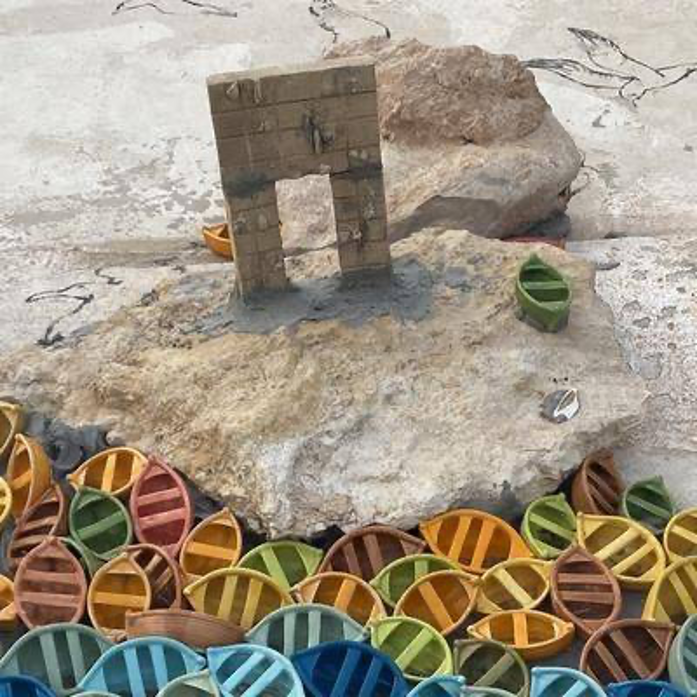
Memorial in Lampedusa. Photo: Alarm Phone
On 4 October, the media reported that the day before at the Italian island Pantelleria around 300 people disembarked on 13 boats that had set sail from Tunisia.
On the same day, the Libyan Stability Support Apparatus confirmed the transfer of 400 people from Nalut to Tripolis, following their expulsion by Tunisian authorities..
On 5 October, Alarm Phone alerted authorities about 22 people in distress south of Sicily. We were relieved to learn a day later that they were rescued to Italy.
On 6 October, the Italian Coastguard rescued a boat with approximately 500 people to Sicily.
On the same day, the Nadir reported that they supported a group of around 30 people in distress at sea. A Frontex speedboat took the people on board to bring them to Lampedusa.
On 7 October, landings on Lampedusa were all by boats that had left from Zawiya and other Libyan routes.
On 9 October, Alarm Phone confirmed that about 60 people, who had called in distress in the shared SAR zone between Malta and Sicily, had reached Italy after being ignored by Maltese authorities.
On 11 October, the Alarm Phone turned nine years old.
On the same day, Refugees in Libya reported that the UNHCR had asked militias to clear the area in front of their office where women and children from Sudan had stayed. This reportedly happened a day ahead of the visit of German and Austrian ambassadors in Libya.
On the same day, more than 130 people – locals, tourists, transnational activists – followed an invitation by the Maldusa project and participated in the CommemorAction for the victims of the horrible shipwreck that had taken place off Lampedusa exactly ten years earlier.
On 12 October, the Tunisian President Saied returned the 60 million received after the negotiations with the EU delegation and sought to blackmail the EU by threatening to reveal confidential information.
On 14 October, despite all obstacles, the ship Mare Ionio returned to the central Mediterranean. Already one day later, they disembarked the 47 people they had rescued at Lampedusa.
On 15 October, over 200 people arrived at Lampedusa from boats departing from Libya and Tunisia. There were more than one-thousand landings during the week.
On 16 October, two boats, each with 31 people on board, who had called Alarm Phone when in distress at sea, were rescued by the Humanity 1.
On 19 October, the Sea Eye 4 rescued 51 people from a rubber boat and was then assigned Brindisi as port of disembarkation, 509 nautical miles away.
On 21 October, Alarm Phone was alerted by relatives to about 300 people in distress in the Maltese SAR zone, fleeing Libya. The Nadir escorted the crowded boat and Seabird monitored the situation. Eventually, the people safely reached Lampedusa, after six Italian vessels had accompanied the fishing boat to the island.
On 23 October, we learned that another boat, carrying 30 people who had alerted Alarm Phone, was pushed back from the Maltese SAR zone to Libya by the militia vessel Tareq Bin Zayed.
On 25 October, Alarm Phone alerted authorities to about 30 people who reported that several people had gone overboard and were in the water. One day later we received information that the 30 people survived and were returned to Libya.
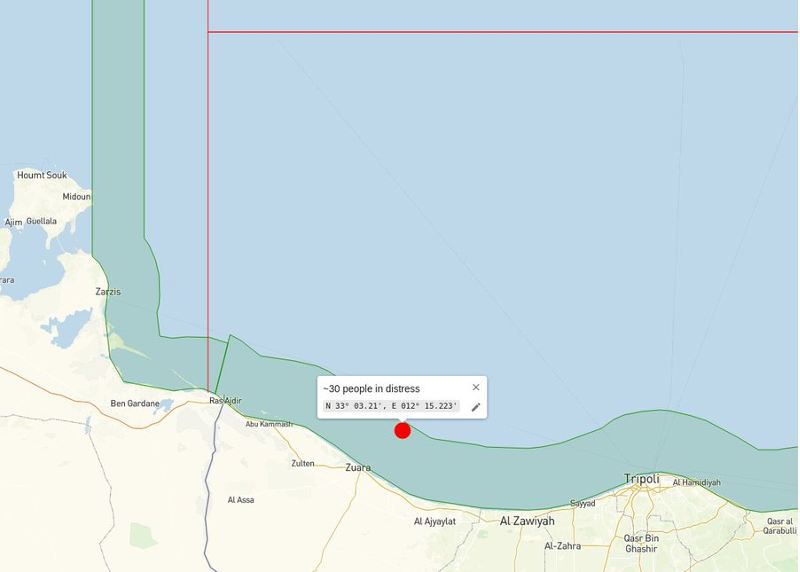
Map showing the position of the boat in distress. Photo: Alarm Phone
On 26 October, another large boat, carrying 347 people that had left from Libya was escorted to the port of Lampedusa by the Italian authorities.
On 27 October, the Ocean Viking evacuated eighteen people from a boat in distress in Maltese SAR zone who had alerted Alarm Phone the day before. The small overcrowded boat had to be sheltered from rough weather by a cargo ship for twenty hours.
On the same day, Sea Eye published a statement on a dangerous rescue operation off Libya after an alert by Alarm Phone. The so-called Libyan Coastguard had instructed the Sea-Eye 4to move away from the scene or they would be attacked. The people on the boat tried to escape from the violent militia. During the attempt, some people fell into the water, whereupon the Sea-Eye crew deployed rescue equipment and a lifeboat. The crew managed to bring all the people on board. Four people were found dead and three in a bad medical state – still, it took hours until Italy sent help. It is unclear if the people who went missing have drowned or were brought back to Libya.
On 28 October, about 50 people who had alerted Alarm Phone stranded on an oil platform in international waters. The people were taken on board of a Tunisian Coastguard ship and brought to Tunisia illegally.
On 30 October, Alarm Phone was in contact with a group of about 68 people who fled from Libya but could not continue because of high waves and strong winds. Eventually, they were intercepted by the Tunisian Coastguard and brought to Tunisia, which is not a safe country.
NOVEMBER
In November, Alarm Phone was alerted to 73 boats in distress, among them 61 departing from Libya, 12 from Tunisia. NGO vessels rescued a total of 22 boats that month – not all of them had alerted Alarm Phone. One boat was rescued by a merchant vessel and pushed back to Libya, another one brought to Malta. In several cases, the Italian Coastguard rescued boats when they had almost reached Lampedusa, and they also coordinated some rescue operations of boats heading towards Sicily or Calabria. We know of 21 interceptions by the so-called Libyan Coastguard. We learned of six shipwrecks in November.
On 1 November, a large boat, carrying about 400 people alerted Alarm Phone and was rescued to Lampedusa.
On 2 November, the Sea Eye 4 was put under administrative detention, which means that civil rescue ships have already been detained for 230 days in total.
On 3 November, Mediterranea announced they would take the Italian government to court against the illegal detention of their ship the Mare Jonio.
On 4 November, the Ocean Viking was instructed by Italian authorities to assist a sailing boat in distress in the Ionian Sea. 75 people who had departed from Izmir, Turkey, were rescued and brought to Italy.
On 5 November, a fishing boat carrying 531 people arrived at Lampedusa. It was the fourth large boat arriving in two weeks. Also many small boats arrived, mainly from Libya.
On 6 November, Italy and Albania announced that they had signed an agreement in Rome pledging to host centres that will process the claims of thousands of migrants rescued by Italy at sea. The centres would be under Italian legal jurisdiction, constructed at Italy’s expense, and are expected to open by spring 2024.
On 9 November, the Life Support of the NGO Emergency rescued 118 people in two operations in very rough seas.
On 10 November, Alarm Phone was alerted to a boat in distress off Zliten, Libya. We learned that the 29 people were forced back to Libya by the merchant vessel ANWAAR LIBYA.
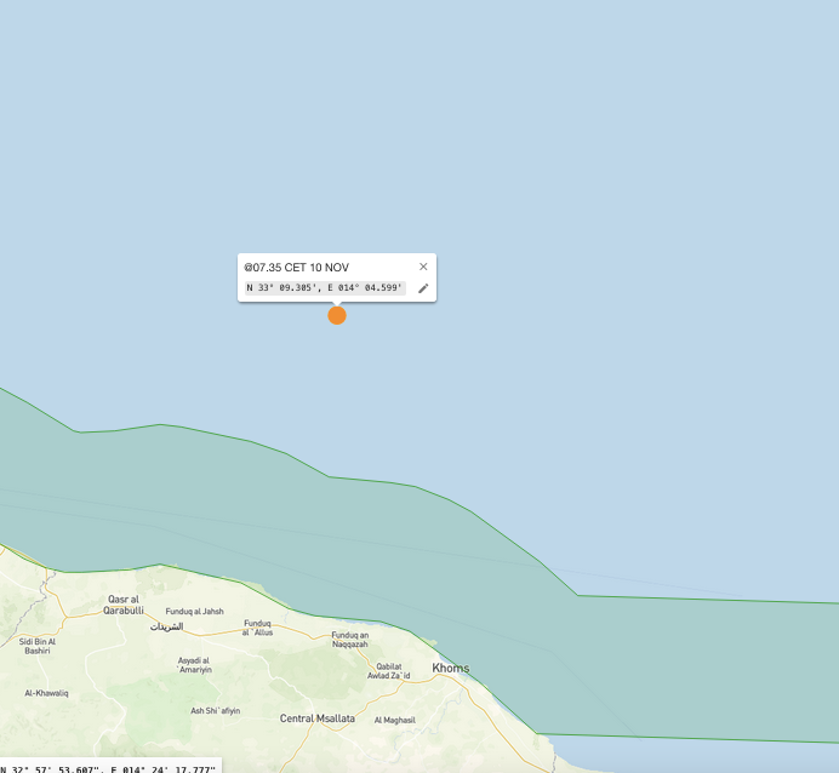
Position of the boat in distress. Photo: Alarm Phone
On the same day, departures from Tunisia resumed. Out of ten boats that reached Lampedusa, only one left from Libya, all others were iron boats from Sfax.
On 11 November, according to media reports in Tunisia, Tunisian authorities conducted 24 operations, intercepting 826 people. Seven were found dead.
On the same day, the Ocean Viking and the Geo Barents performed several rescues, two of them following Alarm Phone alerts in international waters off Libya.
On 12 November, 220 people arrived at Lampedusa on a trawler.
On 14 and 15 November, Alarm Phone alerted authorities to eleven boats in distress. 1,473 people in 29 landings were reported from Lampedusa.
On 15 November, Italian authorities detained the Ocean Viking for 20 days after they had rescued people in distress in international waters off Libya.
On 16 November, Seabird spotted a boat that had alerted Alarm Phone and contacted a nearby merchant vessel. Malta ordered the captain to give the people water and fuel so that they could go to Lampedusa on their own. Calls to Malta were ignored, but after all, the merchant vessel rescued the people and brought them to Malta.
On 20 November, a shipwreck happened near Lampedusa. Eight people went missing, 43 survivors were found on the rocks, two were recovered by fishermen.
On the same day, a fishing boat that left from Libya with 400 people on board arrived independently on Lampedusa where around 800 people in eleven boats had already arrived that day.
On 21 November, the Tunisian National Guard seized seventeen boats in Sfax, five so-called “mediators” were arrested. At sea, they intercepted 709 people in thirty operations.
On the same day, Alarm Phone was in contact with a group that was intercepted by the Tunisian Coastguard and afterwards deported to the desert at the border to Algeria. The 45 people got no help, so some started walking and reached Sfax later by truck, while the others probably remained in the desert and were reachable any more.
On 24 November, the Interior Ministers of Italy, Libya and Tunisia met in Rome for talks on stricter border control and the fight against “irregular migration”, also through the use of “assisted voluntary repatriations”.
On 26 November, a meeting of the chief and other members of the Libyan Border Guard and a technical team of EU Border Assistance Mission took place for talks on training and border security management.
On 27 November, Alarm Phone was alerted by a group of about 250 people fleeing from Libya on a fishing vessel. Eventually, they reached Lampedusa, supported by the Humanity 1 and the Italian Coastguard.
On the same day, it was reported that the Nigerien authorities have repealed LAW 2015-36 on the smuggling of migrants, a law that Alarme Phone Sahara had been fighting against for eight years.
On 30 November, over fourty people almost drowned in a dangerous maneuver by the so-called Libyan Coastguard attacking a rubber boat in distress.
DECEMBER
In December, Alarm Phone was alerted to 72 boats in distress, among them 57 departing from Libya, 13 from Tunisia, one from Lebanon, and one from Turkey. NGO vessels rescued a total of 12 boats that month – not all of them had alerted Alarm Phone. Two boats were rescued by merchant vessels, one was brought to Malta, the other one to Greece. In several cases, the Italian Coastguard rescued boats when they had almost reached Lampedusa, and they also coordinated some rescue operations of boats heading towards Sicily or Calabria. We know of 28 interceptions by the so-called Libyan Coastguard. We learned of four shipwrecks in December.
On 1 December, it was reported that the European Commission gave the green light to a protocol signed between Italy and Albania which would see two Italian-managed asylum centres open in Albania for asylum applications by people rescued in international waters.
On the same day, the Italian Coastguard found 32 people who had alerted Alarm Phone and brought them to Lampedusa.
On 2 December, the rescue ship Humanity 1 was detained for twenty days in Crotone in southern Italy due to lies of authorities about not responding to radio calls from a Libyan patrol boat – in fact, there had been no calls from this patrol boat. Rather, it was the captain of the NGO ship who tried in vain to contact them. Finally, he asked Italian authorities for coordination and followed their instructions to rescue 46 people in distress.
On 3 December, we learned that a merchant vessel had rescued 42 people who had called Alarm Phone in distress, and brought them to Malta.
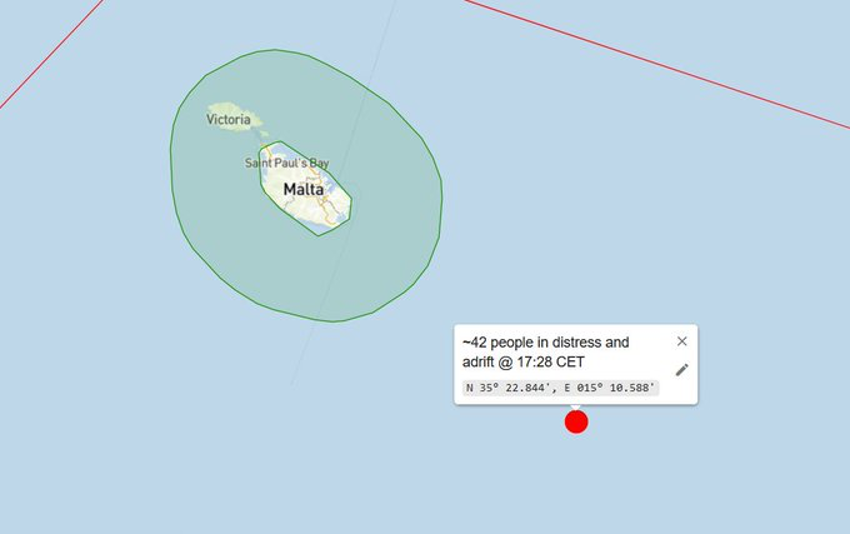
Position of the boat in distress, added by Alarm Phone
On 4 December, a group of twenty people who had left from Lebanon and alerted Alarm Phone arrived in Cyprus.
On 5 December, a stormy sea stopped departures and landings at Lampedusa. The rescue ship Aurora received a fine of 10,000 euros for refusing to take people to Tunisia.
On 7 December, Alarm Phone received a distress call from 45 people amid high waves on an iron boat that could have sunk at any moment. After many hours in urgent distress and of non-assistance by Malta, the sailing vessel Trotamar III of the civil fleet reached the people, handed out lifejackets and stabilized the boat until the Italian Coastguard came and rescued the group to Lampedusa.
On 8 December, the Maldusa project reported that the numbers of people on the move from Tunisia arriving in Italy had drastically decreased since the end of September 2023. At the same time, increasing movements were observed from western Libya, including the phenomenon of crowded big fishing vessels.
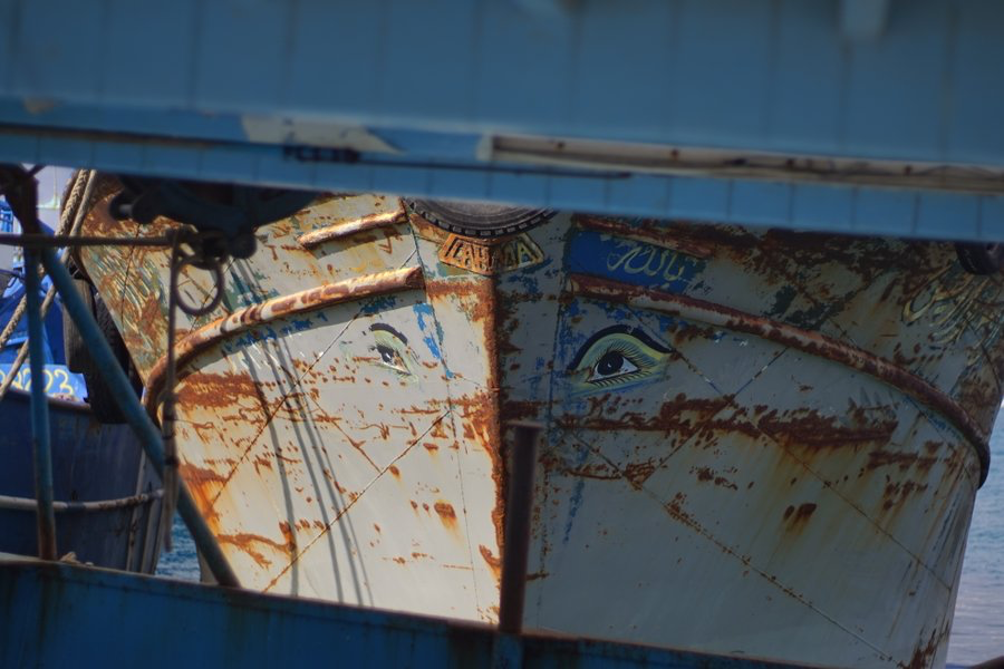
Large metal boat that arrived at Lampedusa. Credit: Maldusa
On 11 December, it was revealed that the Tareq Bin Zayed (TBZ), a Libyan armed group linked to Wagner and accused of grave human rights abuses, illegally pulled back people on the move, using coordinates relayed by European authorities. Alarm Phone had to witness many times how the people onboats in distress who we were in contact with ended up back in Libya, abducted by this militia group.
On 13 December, InfoMigrants reported that since September, over 1,500 migrants had been detained by the Tunisian authorities on land or at sea and been sent to the Libyan border. They were then picked up by Libyan forces and transferred to the detention camps.
On 14 December, the Albania supreme court suspended the migration deal with Italy concerning detention centres managed by Italy to be opened in Albania. According to an appeal by the an opposition party, this proposed measure would violate the country’s constitution and international law.
On 16 December, a shipwreck happened off the coast of Libya. The people on board had reached out to Alarm Phone, who had alerted authorities, but the so-called Libyan Coastguard stated they would not search for them. Only 25 of the 86 people were rescued by the merchant vessel Vos Triton and illegally brought back to Libya. 61 people drowned. Alarm Phone published a report about this shipwreck and denounced it as a consequence of the European border regime.
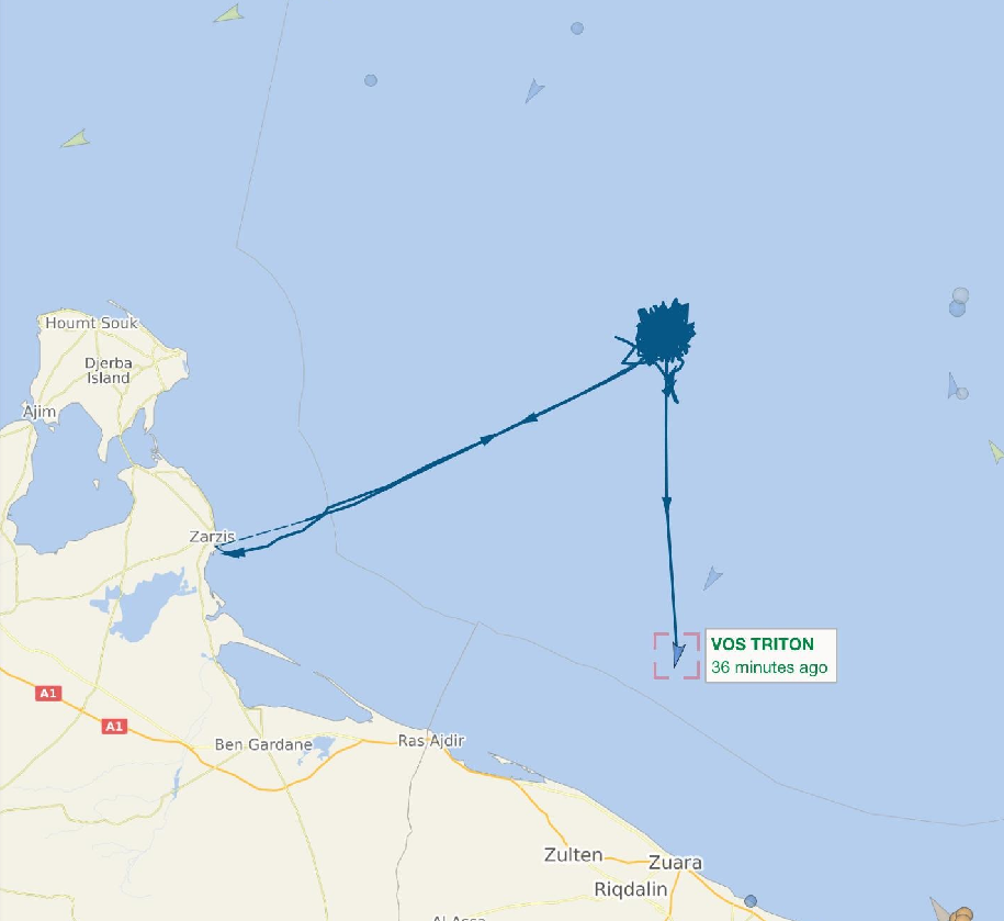
Vesselfinder showing Vos Triton going to Libya after the interception on 14 Dec 2023. Photo: Alarm Phone
On 20 December, the Council and the European Parliament reached a deal on overhauling the EU’s legal framework on asylum and migration. The so-called CEAS (Common European Asylum System) will not stop people from moving, but will make migration routes even more dangerous.
On the same day, the EU finalized a €150,000 deal with Tunisia, a step towards further border violence and externalization of the EU border regime. Members of the Italian government paid a visit to Tripoli and met with Libyan counterparts to discuss cooperation. In Italy, Sant Egidio and the government signed a new protocol to take in 1,500 people from Libya via a humanitarian corridor.
On 21 December, the merchant vessel JAQUES SAADE rescued about 85 people who had alerted Alarm Phone off the coast of eastern Libya and brought them to Kalamata in Greece.
On 24 December, the new NGO ship Sea Watch 5 rescued 119 people on two boats north of Zuwara, Libya. One of them had alerted Alarm Phone.
Between 24 and 27 December, 802 people arrived at Lampedusa. But among the people who arrived, there were also one dead and one injured person, hit by gunfire. Interceptions by the Tunisian Coastguard were also reported.
On 29 December, the Geo Barents rescued 336 people in distress from three overcrowded wooden boats and was assigned Ravenna, a very northern port of safety.
On 30 December, Alarm Phone was called by a boat with 108 people in distress in the SAR zone of Malta. One day later they were rescued to Pozzallo, Italy.
On 31 December, the Ocean Viking was detained for the second time in two months – this time for a minimal deviation from her course to respond to a distress alert on her way to Bari.
Between 29 Dec 2023 and 1st of Jan 2024, the Libyan Stability Support Apparatus (SSA) conducted violent raids on people’s homes in Tripoli and several outskirts, arbitrarily detaining people. Over 2.000 people were forced into detention centres.